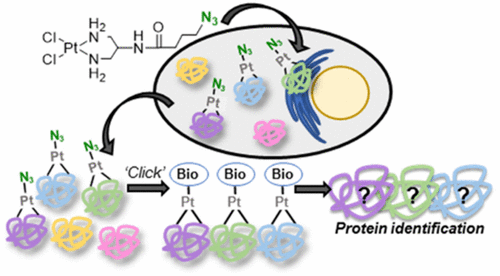当前位置:
X-MOL 学术
›
ACS Chem. Biol.
›
论文详情
Our official English website, www.x-mol.net, welcomes your
feedback! (Note: you will need to create a separate account there.)
Platinum Binds Proteins in the Endoplasmic Reticulum of S. cerevisiae and Induces Endoplasmic Reticulum Stress
ACS Chemical Biology ( IF 3.5 ) Pub Date : 2017-09-28 00:00:00 , DOI: 10.1021/acschembio.7b00553 Rachael M. Cunningham 1 , Victoria J. DeRose 1
ACS Chemical Biology ( IF 3.5 ) Pub Date : 2017-09-28 00:00:00 , DOI: 10.1021/acschembio.7b00553 Rachael M. Cunningham 1 , Victoria J. DeRose 1
Affiliation

|
Pt(II)-based anticancer drugs are widely used in the treatment of a variety of cancers, but their clinical efficacy is hindered by undesirable side effects and resistance. While much research has focused on Pt(II) drug interactions with DNA, there is increasing interest in proteins as alternative targets and contributors to cytotoxic and resistance mechanisms. Here, we describe a chemical proteomic method for isolation and identification of cellular protein targets of platinum compounds using Pt(II) reagents that have been modified for participation in the 1,3 dipolar cycloaddition “click” reaction. Using this method to visualize and enrich for targets, we identified 152 proteins in Pt(II)-treated Saccharomyces cerevisiae. Of interest was the identification of multiple proteins involved in the endoplasmic reticulum (ER) stress response, which has been proposed to be an important cytoplasmic mediator of apoptosis in response to cisplatin treatment. Consistent with possible direct targeting of this pathway, the ER stress response was confirmed to be induced in Pt(II)-treated yeast along with in vitro Pt(II)-inhibition of one of the identified proteins, protein disulfide isomerase.
中文翻译:

铂结合酿酒酵母内质网中的蛋白质并诱导内质网应激
基于Pt(II)的抗癌药被广泛用于治疗多种癌症,但是其不良的副作用和耐药性阻碍了它们的临床疗效。尽管许多研究都集中在Pt(II)药物与DNA的相互作用上,但人们对蛋白质作为细胞毒性和耐药机制的替代靶标和贡献者的兴趣日益浓厚。在这里,我们描述了使用Pt(II)试剂分离和鉴定铂化合物的细胞蛋白靶标的化学蛋白质组学方法,该试剂已被修饰用于参与1,3偶极环加成“点击”反应。使用这种方法可视化和丰富的目标,我们确定了Pt(II)处理的酿酒酵母中的152种蛋白质。感兴趣的是鉴定参与内质网(ER)应激反应的多种蛋白质,这已被认为是响应顺铂治疗的细胞凋亡的重要细胞质介质。与该途径的可能的直接靶向一致,证实ER应激反应在Pt(II)处理的酵母中被诱导,并且其中已鉴定的蛋白质之一,蛋白二硫键异构酶在体外被Pt(II)抑制。
更新日期:2017-09-28
中文翻译:

铂结合酿酒酵母内质网中的蛋白质并诱导内质网应激
基于Pt(II)的抗癌药被广泛用于治疗多种癌症,但是其不良的副作用和耐药性阻碍了它们的临床疗效。尽管许多研究都集中在Pt(II)药物与DNA的相互作用上,但人们对蛋白质作为细胞毒性和耐药机制的替代靶标和贡献者的兴趣日益浓厚。在这里,我们描述了使用Pt(II)试剂分离和鉴定铂化合物的细胞蛋白靶标的化学蛋白质组学方法,该试剂已被修饰用于参与1,3偶极环加成“点击”反应。使用这种方法可视化和丰富的目标,我们确定了Pt(II)处理的酿酒酵母中的152种蛋白质。感兴趣的是鉴定参与内质网(ER)应激反应的多种蛋白质,这已被认为是响应顺铂治疗的细胞凋亡的重要细胞质介质。与该途径的可能的直接靶向一致,证实ER应激反应在Pt(II)处理的酵母中被诱导,并且其中已鉴定的蛋白质之一,蛋白二硫键异构酶在体外被Pt(II)抑制。










































 京公网安备 11010802027423号
京公网安备 11010802027423号